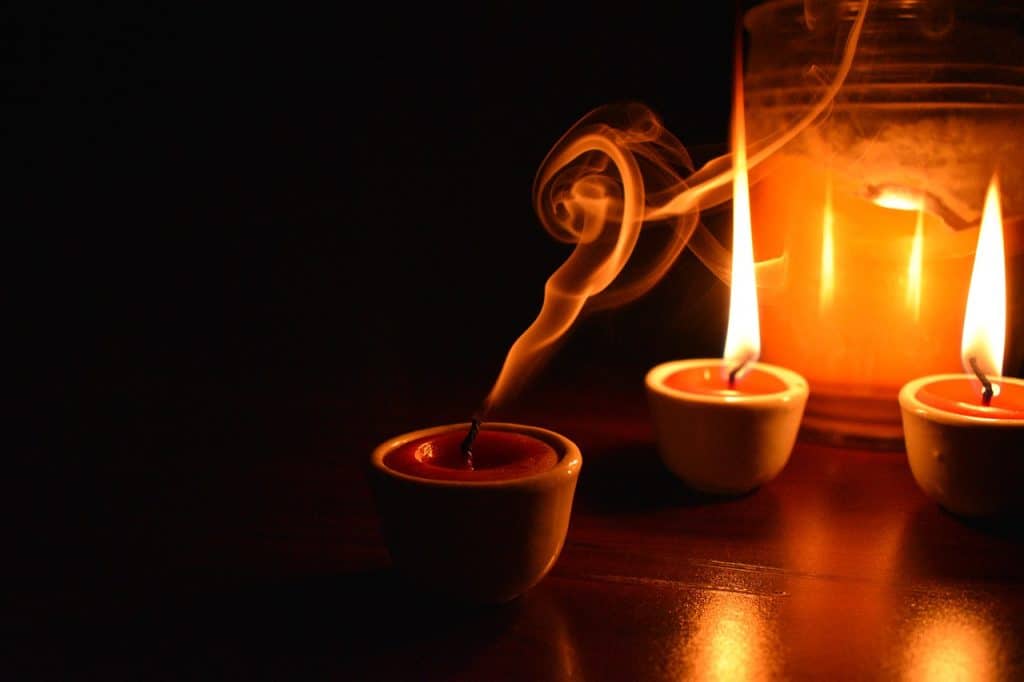Candles are one of the oldest inventions in the world, although nobody knows exactly when they were first invented. Some of the earliest forms of candles can be traced back to thousands of years ago; to an era when candles were predominantly made from boiled down fat or tallow obtained from the carcass of cows and other types of livestock.. Nowadays, different types of candles are more common (e.g. paraffin wax candles). However, one of the questions people tend to ask about all types of candles is
“why do candles flicker?”
WHAT IS A CANDLE?
Many people in the world know what candles are; they are objects made of candle wax and wicks, which produce a flame when lit. This flame provides heat and casts a glow which is often very useful for indoor illumination. As a matter of fact, for a very long time in the past, candles used to be one of the main sources of indoor illumination.
The candle is made up of two main parts which are the candle wax and the wick. Candle wax serves as the primary energy source which drives the burning of the candle’s flame. This is because it is made up of materials that support burning (such materials are also easy to melt); they can be made from different types of substances e.g. beeswax, tallow or fat obtained from livestock and other types of animals, soy wax and other suitable materials. Candle wax is a very important part of a candle, as it forms its shape and provides the fuel that supports the combustion of the candle’s flame. No fire – no matter how small – can burn in the absence of fuel.
Candle wicks, on the other hand, are the black string-like materials that lie at the center of candlesticks, and run through their entire length. Candle wicks are typically made from un-dyed white cotton (before use). They can also be made out of flax, hemp and other types of fibers which are usually braided. The role of a candle’s wick is to soak up melted candle wax and use it to feed the candle’s flame; it is usually designed to burn off, as the candle wax melts, while the candle is in use. Before braided cotton became the popular material for making candle wicks, candle wicks used to be made from plant materials and unprocessed fibers.

WHAT ARE THE TYPES OF CANDLES?
There are different types of candles. This is as a result of the fact that candles have been in existence for a very long time; therefore, it is only natural that many materials have been tried and tested for the purpose of being used in their production. Consequently, candles can be grouped into different categories, based on the following sources of differences;
- The kind of wax used in their making
The kind of candle wax used in making candles matters. There are different kinds of materials that could fulfill that purpose (i.e. there are different types of materials that can melt when burned in other to provide a source of fuel to a candle’s flames). No fire or flame, no matter how small can burn or be sustained in the absence of fuel, and the provision of this fuel is one of the most important functions of candle wax in a candle stick (aside for the fact that candle wax also gives a shape to the candle, depending of the type of mold used during the process of candle making).
The different types of candle wax include tallow or boiled down fat (which is typically derived from the carcasses of cows and other type of livestock), beeswax, soy wax, paraffin wax and other kinds of wax, which may be combinations of other types of waxes (in varying percentages).
Tallow candles were some of the earliest types of candles to ever exist in the world. Following which paraffin wax candles became extremely popular. The type of wax used in making a candle matters, as it tends to affect the burning time of the candle, and the purity of the flame produced from it (for example, beeswax is known to produce some of the cleanest types of flames in the world).

- The kind of wick used in their making
Candles can also be differentiated from one another based on the type of wick used in making them. Candle wicks are typically made from braided cotton fibers which do not contain dyes. However, they may also be made from other types of fibers and even plant materials.
The type of wick used in making a candle tends to affect the quality of the candle’s flame and how quickly the candle burns, in a lot of cases.
- Color
Candles can be distinguished from one another based on the color of their wax. The most popular type of candles in the world is white candles. However, candles may also exist in other colors and shades, based on the type of dye used in their making.
WHY DO CANDLES FLICKER?
One of the questions many people ask regarding candles is “why do candles flicker?” This is because the flickering of candles can affect the way a candle burns; including its burning time and the combustion of the candle’s flame. Also, the way a candle flickers may shorten its longevity and lifespan.
There are a lot of theories however, the simple answer is to this question is that; candles tend to flicker when they are exposed to wind.
Strong wind or moving air can affect the direction of a candle flame. It can also put out a candle in a lot of cases. This is because fuel is not the only thing needed to sustain a candle’s flame. Oxygen is needed too. And while it may seem that moving wind may contain a lot of oxygen, which should sustain a candle’s flame, moving wind also has a strong force, which can make a flame flicker and eventually put it out; in extreme cases.





Candles flicker when in a jar or vessel , if the flame is lower than the height if the vessel
It is trying to draw air in so in effect the candle is gasping!
Trim the wick shorter and the flicker will reduce.
If you candle us smoking it’s a cheap wick Chuck the candle away!!!